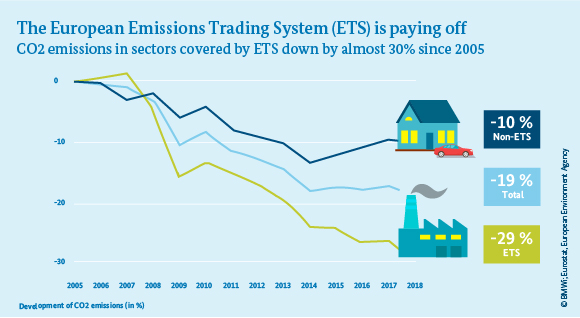The success story of emissions trading
Since the European Emissions Trading System (ETS) was established in 2005, CO2 emissions in the sectors covered by the ETS have fallen by almost 30% – a decrease that far exceeds the EU-wide target of 21%.
 © BMWi; Eurostat, European Environment Agency
© BMWi; Eurostat, European Environment Agency
According to Eurostat, the statistical office of the European Union, and the European Environment Agency, the CO2 emissions covered by the European Emissions Trading system (ETS) have declined far more markedly than in other sectors. Emissions from the electricity, industry and intra-EU aviation sectors are subject to a cap set by the EU ETS. For other sectors such as transport, heat and land use, there is no common trading system in place. At just 10%, the decrease in the sectors that are not being covered by the EU Emissions Trading System, such as transport and buildings, has been considerably smaller.
The aim of the European Emissions Trading System is to help reduce greenhouse gas emissions from the participating energy sector and energy-intensive industries. Covering almost half of all greenhouse gas emissions generated in Europe, the scheme is the key instrument of European climate policy. In 2005, the ETS was established as a means of implementing the Kyoto Protocol. Participating companies are required to submit allowances for any emissions they generate, and they can trade in these allowances with each other. Here are some resources that explain how exactly the ETS works.

